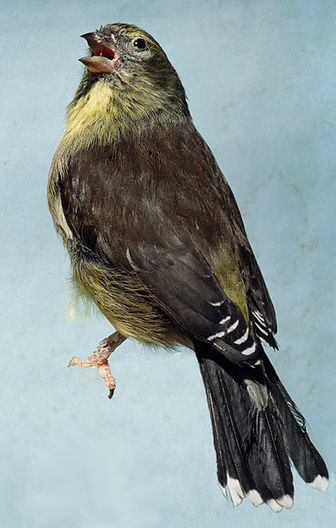Cape Siskin
This species is sometimes considered to be conspecific with the Drakensberg Siskin, Serinus symonsi of eastern Cape Province, western Natal and Lesotho in which case the nominate western form is S. t totta, and the eastern form is S. t. symonsi.

Original source: Antonio Arnaiz-Villena, Valentin Ruiz-del-VallePermission(Reusing this file)The permission for use of this work has been archived in the Wikimedia OTRS system.It is available as ticket #2011012310012868 for users with an OTRS account. If you wish to reuse this work elsewhere, please read the instructions at COM:REUSE. If you are a Commons user and wish to confirm the permission, please leave a note at the OTRS noticeboard.Ticket link: https://ticket.wikimedia.org/otrs/index.pl?Action=AgentTicketZoom&TicketNumber=2011012310012868
Author: Antonio Arnaiz-Villena, Valentin Ruiz-del-VallePermission(Reusing this file)The permission for use of this work has been archived in the Wikimedia OTRS system.It is available as ticket #2011012310012868 for users with an OTRS account. If you wish to reuse this work elsewhere, please read the instructions at COM:REUSE. If you are a Commons user and wish to confirm the permission, please leave a note at the OTRS noticeboard.Ticket link: https://ticket.wikimedia.org/otrs/index.pl?Action=AgentTicketZoom&TicketNumber=2011012310012868
Permission: GNU Free Documentation License
The Cape Siskin is classified as Least Concern. Does not qualify for a more at risk category. Widespread and abundant taxa are included in this category.
The Cape Siskin, Serinus totta, is a small passerine bird in the finch family. It is an endemic resident breeder in the southern Cape Province of South Africa. It is sometimes assigned to the genus Pseudochloroptila as Pseudochloroptila totta. This species is sometimes considered to be conspecific with the Drakensberg Siskin, Serinus symonsi of eastern Cape Province, western Natal and Lesotho in which case the nominate western form is S. t totta, and the eastern form is S. t. symonsi. More
There is no range overlap with the slightly smaller Cape Siskin, which has white spots on the flight feathers and tail and more uniform upperparts. The Drakensberg Siskin’s call is a schwee, often given in flight. and the song, like that of Cape Siskin, is a weak, pleasant warble similar to the Yellow-fronted Canary. More
The Cape Siskin is about the size of a Hooded Siskin (12cm). Its' back, wing coverts, rump and the upper tail coverts are chocolate brown. The head, nape and sides of neck are yellowish gray and olive. Fine dark brown streaks are most prominent on the head and the sides of the throat, while the flight feathers (only in the P.t.totta), have white spots on the tips. Its inquisitiveness and its charming twittering makes these birds one of my favorite Siskins. More
| Cape Siskin in English Use Babylon to translate to various languages Copyright © 1997-2007 Babylon. More
Buttonquail and Cape Siskin, and seabirds such as African Penguin. More
Groups of Cape Siskin invariably forage around the campsite, and Greater Double-collared Sunbird feed in the garden of the office, where you need to obtain a day permit to enter the forest. From here it is a short, steep walk down a bracken-covered slope known as Bosbokrand ( More
The Cape Siskin averages 13 cm in length. The flight feathers and tail have white spots on the tips which are diagnostic for both sexes, and especially visible in flight. The adult male has a light brown back, wing coverts, rump and upper tail and yellow underparts. The head, nape and sides of neck are yellowish grey and olive. Fine dark brown streaks are most prominent on the head and the sides of the throat. More
CAPE SISKIN, while the Berg River Estuary and it's great estuarine birding is within feasible striking distance from Mountain Mist. Comments: Mountain Mist Chalets are situated in a private nature reserve high up on the mountains above the small village of Aurora. There are some lovely and not too strenuous walks in the reserve and the view of the Atlantic coast from north of Velddrif to south of Langebaan Lagoon is something that should not be missed. More
This Cape Siskin was photographed recently at Cape Point by Barrie Rose. It is partially leucistic, showing paleness on the body instead of the normal darker colouration. More
Family : Fringillidae
Genus : Serinus
Species : totta
Authority : (Sparrman, 1786)

